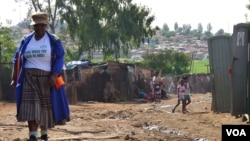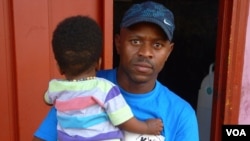KLIPTOWN, SOWETO TOWNSHIP —
In South Africa, more than a half million pupils are busy writing their marathon end of high-school examination, known here as “matric." This is a decisive time for the youth, as the matric has become a much-needed diploma to get a job in a country where 30 percent of the active population is unemployed - and more than 45 percent of blacks. But studying for matric is particularly hard in the poorest communities which lack basic amenities.
At a local non-governmental organization in Kliptown, one of the most destitute areas of Soweto township, one man makes all the difference for the youth. He is Thulani Madondo, a founder of the Kliptown Youth Project, or KYP.
"This is our communal tap. This tap will be shared by 80 to 100 families," he explains. "Kliptown is a community of plus or minus 45 000 people without a lot of basic things like electricity. Our homes are built out of corrugated iron, we call them... it's shacks. And children walk about 25 to 30 minutes to their respective schools, depending on what language they speak.”
In Africa's richest country, Kliptown is the dark side of the coin. While the wealthy northern suburbs of Johannesburg remind one of Los Angeles, with their wide, shady avenues and modern parks and shopping malls, desolated Kliptown is simply an undeveloped slum. Because of a lack of proper sanitation, a thin river of used water snakes between the box-like houses that are burning hot in summer, freezing cold in winter.
Life here can be bleak; but not desperate, thanks in part to people like Thulani Madondo.
Madondo wears his young age, barely 30, like a badge of pride. In five years, the organization he created, the Kliptown Youth Project, has become a beacon of hope for the neighborhood youth.
Hope for a brighter future
Andisiwe, one of the young people who attended the after-school program, is now waiting to go and study at the university. She wants to study humanities.
"I grew up in a shack," she says. "But in ten years... just a big house. A big house with a swimming pool and everything in it!"
Nineteen-year-old Lindiwe Manate, whose bubbly personality and optimistic outlook belies the bleak environment she grew up in, says Madondo's program helped her a lot.
"If you know exactly what you want, and you know where you want to be, then you'll come here because you know that's a place where you deal with people who have a dream, people who want to make their future to be successful, people who want to change. That's my role model. That's why I'm always with Thulani," she says.
A strong smell of cabbage stew wafts from an empty classroom. It's 3:00 p.m., time for a warm meal for the 400 children and teens who come every day to KYP, either to get help with their homework, enjoy the only place in the neighborhood with an Internet connection, toss the football or, for the little ones, to climb the jungle gym.
Local involvement
Starting as an informal study-support group led by local volunteers, KYP has become a large organization which now claims the support of a dozen NGOs or corporations. It is housed in a former Catholic school building.
Madondo says it is up to locals like him, who grew up in Kliptown, to be agents of change.
“Leaving or going away, it would have been a betrayal to this community because I know exactly what it means to go to school with an empty stomach, to go to bed with an empty stomach. This is another thing that we teach the kids and young people that we work with: if it happens that you succeed, you need to come back and help those that are still struggling," said Madondo.
The preparation for the end of high school exam, the "matric," is particularly important as the exam is a key to escaping Kliptown's dire conditions. Madondo is proud of the fact that 21 youths he taught have been able to enroll in colleges or universities - a feat that less than 10 percent of black South Africans achieve, according to the 2011 census.
Partnering for training, jobs
KYP also partners with the private sector to try and find training and jobs for the youths.
Kashia Pierce works for a Long Beach, California, based company that provides scholarship and learning to disadvantaged youth. She says after-school training is essential in modern South Africa to fix the glaring holes in the local education system. She says the problem is not limited to poor neighborhoods like Kliptown.
"What happens is that the workers out there, when they apply for a position, we as [a] company, we require that they have basic numeracy, but they're not meeting that," she said. "So that means that you can have applicants to jobs in your company, they have matric, but, for all intent and purposes, they can't really count... We see it all over the place. It's heartbreaking. It honestly is heartbreaking.”
Experts say that because black South Africans have suffered so long from segregation and apartheid, many have developed a sense of entitlement to the state's services. But through his organization, Madondo hopes to switch this mindset towards a "can do" attitude.
At a local non-governmental organization in Kliptown, one of the most destitute areas of Soweto township, one man makes all the difference for the youth. He is Thulani Madondo, a founder of the Kliptown Youth Project, or KYP.
"This is our communal tap. This tap will be shared by 80 to 100 families," he explains. "Kliptown is a community of plus or minus 45 000 people without a lot of basic things like electricity. Our homes are built out of corrugated iron, we call them... it's shacks. And children walk about 25 to 30 minutes to their respective schools, depending on what language they speak.”
In Africa's richest country, Kliptown is the dark side of the coin. While the wealthy northern suburbs of Johannesburg remind one of Los Angeles, with their wide, shady avenues and modern parks and shopping malls, desolated Kliptown is simply an undeveloped slum. Because of a lack of proper sanitation, a thin river of used water snakes between the box-like houses that are burning hot in summer, freezing cold in winter.
Life here can be bleak; but not desperate, thanks in part to people like Thulani Madondo.
Madondo wears his young age, barely 30, like a badge of pride. In five years, the organization he created, the Kliptown Youth Project, has become a beacon of hope for the neighborhood youth.
Hope for a brighter future
Andisiwe, one of the young people who attended the after-school program, is now waiting to go and study at the university. She wants to study humanities.
"I grew up in a shack," she says. "But in ten years... just a big house. A big house with a swimming pool and everything in it!"
Nineteen-year-old Lindiwe Manate, whose bubbly personality and optimistic outlook belies the bleak environment she grew up in, says Madondo's program helped her a lot.
"If you know exactly what you want, and you know where you want to be, then you'll come here because you know that's a place where you deal with people who have a dream, people who want to make their future to be successful, people who want to change. That's my role model. That's why I'm always with Thulani," she says.
A strong smell of cabbage stew wafts from an empty classroom. It's 3:00 p.m., time for a warm meal for the 400 children and teens who come every day to KYP, either to get help with their homework, enjoy the only place in the neighborhood with an Internet connection, toss the football or, for the little ones, to climb the jungle gym.
Local involvement
Starting as an informal study-support group led by local volunteers, KYP has become a large organization which now claims the support of a dozen NGOs or corporations. It is housed in a former Catholic school building.
Madondo says it is up to locals like him, who grew up in Kliptown, to be agents of change.
“Leaving or going away, it would have been a betrayal to this community because I know exactly what it means to go to school with an empty stomach, to go to bed with an empty stomach. This is another thing that we teach the kids and young people that we work with: if it happens that you succeed, you need to come back and help those that are still struggling," said Madondo.
The preparation for the end of high school exam, the "matric," is particularly important as the exam is a key to escaping Kliptown's dire conditions. Madondo is proud of the fact that 21 youths he taught have been able to enroll in colleges or universities - a feat that less than 10 percent of black South Africans achieve, according to the 2011 census.
Partnering for training, jobs
KYP also partners with the private sector to try and find training and jobs for the youths.
Kashia Pierce works for a Long Beach, California, based company that provides scholarship and learning to disadvantaged youth. She says after-school training is essential in modern South Africa to fix the glaring holes in the local education system. She says the problem is not limited to poor neighborhoods like Kliptown.
"What happens is that the workers out there, when they apply for a position, we as [a] company, we require that they have basic numeracy, but they're not meeting that," she said. "So that means that you can have applicants to jobs in your company, they have matric, but, for all intent and purposes, they can't really count... We see it all over the place. It's heartbreaking. It honestly is heartbreaking.”
Experts say that because black South Africans have suffered so long from segregation and apartheid, many have developed a sense of entitlement to the state's services. But through his organization, Madondo hopes to switch this mindset towards a "can do" attitude.






